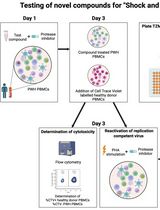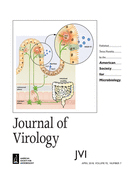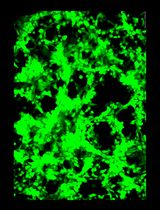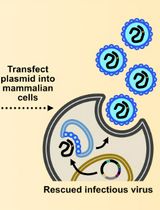- EN - English
- CN - 中文
Random Insertional Mutagenesis of a Serotype 2 Dengue Virus Clone
2型登革病毒克隆的随机插入诱变
发布: 2018年08月20日第8卷第16期 DOI: 10.21769/BioProtoc.2975 浏览次数: 6325
评审: Modesto Redrejo-RodriguezSesha Lakshmi Arathi PaluriAnonymous reviewer(s)

相关实验方案

诱导型HIV-1库削减检测(HIVRRA):用于评估外周血单个核细胞中HIV-1潜伏库清除策略毒性与效力的快速敏感方法
Jade Jansen [...] Neeltje A. Kootstra
2025年07月20日 2273 阅读
Abstract
Protein tagging is a powerful method of investigating protein function. However, modifying positive-strand RNA virus proteins in the context of viral infection can be particularly difficult as their compact genomes and multifunctional proteins mean even small changes can inactivate or attenuate the virus. Although targeted approaches to functionally tag viral proteins have been successful, these approaches are time consuming and inefficient. A strategy that has been successfully applied to several RNA viruses is whole-genome transposon insertional mutagenesis. A library of viral genomes, each containing a single randomly placed small insertion, is selected by passaging in cell culture and the insertion sites can be identified using Next Generation Sequencing (NGS). Here we describe a protocol for transposon mutagenesis of the 16681 strain of dengue virus, serotype 2. Mutant dengue virus libraries containing short randomly placed insertions are passaged through mammalian cells and insertions are mapped by NGS of the viable progeny. The protocol is divided into four stages: transposon mutagenesis of a dengue cDNA clone, viral genome transfection into permissive cells, isolation of viral progeny genomes, and sequencing library preparation.
Keywords: Transposon (转座子)Background
A key aspect of understanding viral pathogenesis is elucidating the viral proteins’ functions during infection. However, viral proteins, particularly those encoded by compact viral genomes, are often multifunctional and therefore more challenging to study, in part because they are often difficult to tag (epitope tags, fluorescent proteins, etc.) in the context of an infectious virus genome without compromising viral infection. One workaround is to express individually tagged proteins in cells, which may result in an incomplete picture of the viral protein’s function as the other viral proteins are not present. It also does not directly determine if the functional tag interferes with the tagged protein’s function(s) in viral infection. Another approach is the empiric tagging of viral proteins in the context of an infectious virus genome, which ensures viral viability but is an inefficient process that is difficult to scale.
Transposon mutagenesis can help dissect the functions of proteins under various experimental conditions and has been used at a whole genome scale to elucidate the role of various proteins during microbial infections. This approach has been successfully applied to a number of positive-strand RNA viruses (Arumugaswami et al., 2008; Beitzel et al., 2010; Teterina et al., 2011; Thorne et al., 2012; Remenyi et al., 2014; Eyre et al., 2017; Fulton et al., 2017). By coupling the transposon mutagenesis approach to Next Generation Sequence, a map of sites in the viral genome that tolerate insertions can be determined with unprecedented resolution. Once these sites are identified, functional tags can be introduced into these sites through site-directed mutagenesis. This protocol describes whole-genome transposon insertion mapping applied to the 16681 strain of serotype 2 dengue virus.
Materials and Reagents
- Pipette tips (Fisher Scientific, catalog numbers: 02-707-80 ; 02-707-167 )
- 6-well plate (Corning, catalog number: 3506 )
- 0.22 μm sterile filter (Corning, catalog number: 431219 )
- Cell scraper (Corning, catalog number: 3010 )
- 10-beta chemically competent E. coli (New England Biolabs, catalog number: C3019H ) or equivalent–genotype used Δ(ara-leu) 7697 araD139 fhuA ΔlacX74 galK16 galE15 e14- ϕ80dlacZΔM15 recA1 relA1 endA1 nupG rpsL (StrR) rph spoT1 Δ(mrr-hsdRMS-mcrBC)
- Primers
- Fragment A (SacI/NarI) forward with T7 sequence
GAAATTAATACGACTCACTATAAGTTGTTAGTCTACGTG - Fragment A (SacI/NarI) reverse
GTCATAGTGGCGCCTACCATAACCATCACTCTTCCC - Fragment B (NarI/EcoRV) forward
GGTTATGGTAGGCGCCACTATGACGGATGAC - Fragment B (NarI/EcoRV) reverse
CTGCTTCCTGATATCTCTGCCTGGTCTTCCC - Fragment C (EcoRV/XbaI) forward
GACCAGGCAGAGATATCAGGAAGCAGTCCAATCC - Fragment C (EcoRV/XbaI) reverse
AGAACCTGTTGATTCAACAGCAC - Ion Torrent P1 adaptor top oligo
CCACTACGCCTCCGCTTTCCTCTCTATGGGCAGTCGGTGAT - Ion Torrent P1 adaptor bottom oligo
<phos>ATCACCGACTGCCCATAGAGAGGAAAGCGGAGGCGTAGTGGTT - Modified Ion Torrent A adaptor top oligo
<phos>GGCCGCCTGAGTCGGAGACACGCAGGGATGAGATGGTT - Modified Ion Torrent A adaptor bottom oligo
CGGACTCAGCCTCTGTGCGTCCCTACTCTACC
- Fragment A (SacI/NarI) forward with T7 sequence
- SacI (New England Biolabs, catalog number: R3156 )
- NarI (New England Biolabs, catalog number: R0191 )
- EcoRV (New England Biolabs, catalog number: R3195 )
- XbaI (New England Biolabs, catalog number: R0145 )
- NotI (New England Biolabs, catalog number: R0189 )
- Mutation Generation System kit (Thermo Fisher Scientific, catalog number: F-701 )
- Carbenicillin (Fisher Scientific, catalog number: BP26481 )
- Kanamycin (Thermo Fisher Scientific, catalog number: 11815024 )
- Promega Wizard Maxiprep kit (Promega, catalog number: A7270 )
- Promega Gel Purification kit (Promega, catalog number: A9281 )
- m7g(5')ppp(5')A RNA Cap Structure analog (New England Biolabs, catalog number: S1405S )
- Agarose (Thermo Fisher Scientific, catalog number: 16500100 )
- Q5 polymerase (New England Biolabs, catalog number: M0493 )
- T7 MEGAscript in vitro RNA translation kit (Thermo Fisher Scientific, catalog number: AM1334 )
- ZYMO Quick-RNA Viral kit (ZYMO RESEARCH, catalog number: R1034 )
- Applied Biosciences High Capacity cDNA kit (Thermo Fisher Scientific, catalog number: 4368814 )
- Ion Library Taqman Quantitation kit (Thermo Fisher Scientific, catalog number: 4468802 )
- 10x TBE (Fisher Scientific, catalog number: BP1333 )
- T4 DNA ligase (New England Biolabs, catalog number: M0202 )
- T4 PNK (New England Biolabs, catalog number: M0201 )
- dNTPs (Thermo Fisher Scientific, catalog number: R1121 )
- AMPure XP Beads (Beckman Coulter, catalog number: A63881 )
- LB medium (Fisher Scientific, catalog number: BP1425-500 )
- PEG 8000 (Thermo Fisher Scientific, catalog number: BP233-100 )
- Vero cells (ATCC, catalog number: CCL-81 )
- TransMessenger transfection reagent (QIAGEN, catalog number: 301525 )
- Full-length dengue virus clone 16681 serotype 2 cDNA (in plasmid pD2/IC-30P-NBX, Huang et al., 2010).
Note: This cDNA was a generous gift of Dr. Huang from the Centers for Disease Control.
Equipment
Note: No specific equipment is necessary and any model of the following should suffice.
- Balance
- Pipettes
- Heat block
- Incubator
- Thermal cycler
- Water bath
- Microcentrifuge
- Magnet for Ampure XP bead purification
Procedure
文章信息
版权信息
© 2018 The Authors; exclusive licensee Bio-protocol LLC.
如何引用
Perry, J. W. and Tai, A. W. (2018). Random Insertional Mutagenesis of a Serotype 2 Dengue Virus Clone. Bio-protocol 8(16): e2975. DOI: 10.21769/BioProtoc.2975.
分类
微生物学 > 微生物-宿主相互作用 > 病毒
微生物学 > 微生物遗传学 > 诱/突变
分子生物学 > DNA > 诱/突变
您对这篇实验方法有问题吗?
在此处发布您的问题,我们将邀请本文作者来回答。同时,我们会将您的问题发布到Bio-protocol Exchange,以便寻求社区成员的帮助。
提问指南
+ 问题描述
写下详细的问题描述,包括所有有助于他人回答您问题的信息(例如实验过程、条件和相关图像等)。
Share
Bluesky
X
Copy link











